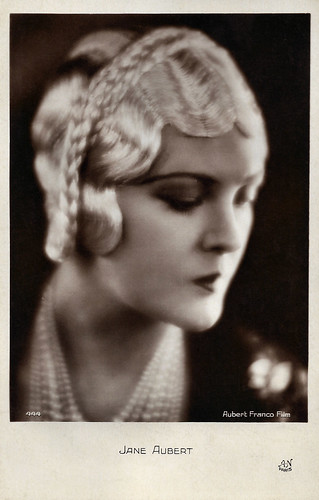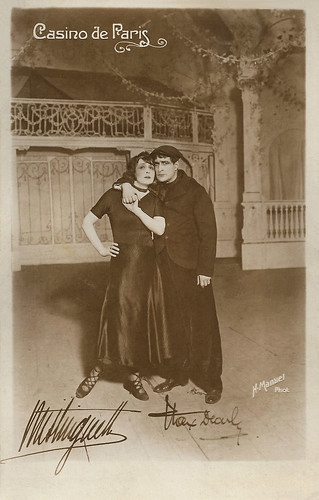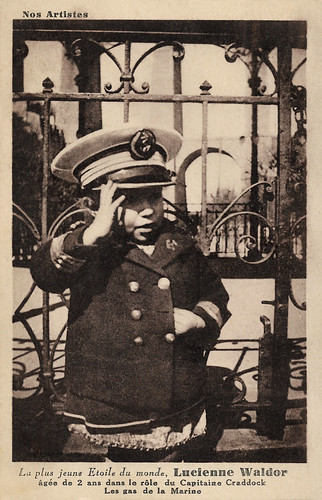
American postcard by Tichnor Bros, Boston, Mass., no. L-39. Photo: Richard Miller, 1945. Caption: Thinking of You.
By 1953, Marilyn Monroe (1926-1962) was one of the most marketable Hollywood stars, with leading roles in three films: the noir Niagara, which focused on her sex appeal, and the comedies Gentlemen Prefer Blondes and How to Marry a Millionaire, which established her star image as a "dumb blonde". Although she played a significant role in the creation and management of her public image throughout her career, she was disappointed at being typecast and underpaid by the studio. She was briefly suspended in early 1954 for refusing a film project but returned to star in one of the biggest box office successes of her career, The Seven Year Itch (1955).

German postcard by Ross Verlag, no. 3357/2, 1928-1929.
Rina De Liguoro (1892-1966) was the last diva of the Italian silent cinema of the 1920s. She had her breakthrough in 1924 as the sensual, untamed Roman empress Messalina, and the beautiful countess continued her glittering career in such epics as Quo Vadis (1924), Casanova (1927), and Cecil B. De Mille's notorious flop Madam Satan (1930).

Dutch postcard, no. 3395. Photo: Paramount.
American actress, dancer, and comedian Olga San Juan (1927-2009) was mainly active in films during the 1940s. San Juan was dubbed the 'Puerto Rican Pepperpot' or 'Beauty Siren' for singing and dancing roles alongside Bing Crosby, Fred Astaire, and many others.

French postcard by Cinémagazine Edition, Paris, no. 328. On the card is his name written as Harrisson Ford (sic).
Harrison Ford (1884-1957) was an American stage and film actor. He was a leading Broadway theater performer and a star of the silent film era.

French postcard. Photo: Film du Synchronisme Cinématique. Fritz Kortner in Das Leben des Beethoven/The Life of the Beethoven (Hans Otto, 1927). Caption: Beethoven and his adopted nephew.
Austrian-born stage and film actor and theatre director Fritz Kortner (1892-1970) was one of the best-known character actors of the German silent cinema. His specialty was playing sinister and threatening roles.

British postcard by Poppictures, London, bi. C 615. Photo: Cliff Richard and the cast of the TV Series The Young Ones (1982-1984) with Rik Mayall, Adrian Edmondson, Nigel Planer, and Christopher Ryan.
In the late 1950s, British singer, actor, and Sir Cliff Richard (1940) was known as Britain's answer to Elvis Presley. The ‘Cliff Richard musical’ became the number one cinema box office attraction in Britain for both 1962 and 1963.
The Young Ones (1982-1984) is a comedy series about the crazy and sometimes surreal adventures of four very different students in Thatcher's Britain. Ben Elton, Rik Mayall, Lise Mayer, and Alexei Sayle wrote the twelve episodes of the show. Rik Mayall, Adrian Edmondson, Nigel Planer, and Christopher Ryan play the four mismatched university students, who share a house in North London: Neil, the hippy; Mike, the cool person; Rick, a would-be anarchist studying sociology; and Vyvyan, the punk medical student who is prone to extreme violence. Together with their bastard Russian landlord (Alexei Sayle), the world of these 'bachelor boys' is surreal and violent, but ultimately hilarious.

British postcard by Reflex Marketing LTD., Wellingborough, England, no. PC 243. Photo: Hemsdale Film Corporation, 1986. Charlie Sheen in Platoon (Oliver Stone, 1986). Caption: The first casualty of war is innocence.
American actor Charlie Sheen (1965) had his breakthrough with Oliver Stone's Oscar-winning epic Platoon (1986). Other hits were Wall Street (1987), Young Guns (1988), Major League (1989), Navy SEALs (1990), The Three Musketeers (1993), and Terminal Velocity (1994). He made a come-back with the sitcom Two and a Half Men (2003).

French postcard by A.N. (A. Noyer), Paris, no. 444. Photo: Aubert Franco Film. Jane Aubert in La Possession/The ownership (Léonce Perret, 1929).
Jeanne Aubert a.k.a. Jane Aubert (1900-1988) was a French singer and actress, who was successful in Paris but also on Broadway and the West End.

Dutch postcard, no. 475. Photo: M.G.M. (Metro Goldwyn Mayer). Robert Montgomery and Tallulah Bankhead in Faithless (Harry Beaumont, 1932).
Robert Montgomery, who was born in 1904, was left penniless at the age of sixteen and became a mechanic's mate on a railway, a deckhand, and finally property man to a touring company, which resulted in a stage career. Played in stock for some time, mostly old man characters, and eventually reached New York. Film debut in So This is College. Among his later pictures were Nor More Ladies, Mutiny on the Bounty, and Piccadilly Jim.
American actress Tallulah Bankhead (1902-1968) was the most popular star of London's famed West End in the 1920s. After starring in several well-received plays, she gained the attention of Paramount Pictures executives and returned to the United States to try her hand at the film world. Tallulah's personality did not shine on film as Paramount executives had hoped. She appeared in such films as Devil and the Deep (1932) with Gary Cooper, Charles Laughton and newcomer Cary Grant, and Lifeboat (1944). While she made most of her fame on the stages of the world, the film industry and its history became richer because of her talent and her very colorful personality. Today her phrase, "Hello, Dahling" is known throughout the entertainment world.

Dutch postcard, no. 513. Photo: M.G.M. Jean Harlow and Clark Gable in Red Dust (Victor Fleming, 1932). Sent by mail in 1935.
American film actress Jean Harlow (1911–1937) was one of the sex symbols of the 1930s. With her come-hither body, platinum blonde hair, and a keen sense of humour, she had her breakthrough in Howard Hughes' World War I epic Hell's Angels (1930). Frank Capra's Platinum Blonde (1931) cemented her role as America's new sex symbol. In 1932, she signed with Metro-Goldwyn-Mayer and became the leading lady in a string of hit films. These included Red Dust (1932), Dinner at Eight (1933), Reckless (1935), and Suzy (1936). Among her frequent co-stars were William Powell, Spencer Tracy, and, in six films, Clark Gable.
With his natural charm and knowing smile, Clark Gable (1901-1959) was 'The King of Hollywood' during the 1930s. He often portrayed down-to-earth, bravado characters with a carefree attitude, and was seen as the epitome of masculinity. Gable won an Academy Award for Best Actor for It Happened One Night (1934), and was nominated for leading roles in Mutiny on the Bounty (1935) and for his best-known role as Rhett Butler in Gone with the Wind (1939).

American Arcade postcard by Mutoscope. Photo: Music Corporation of America (MCA).
Count Basie (1904-1984) was an American jazz pianist, organist, bandleader, and composer. In 1935, Basie formed his own jazz orchestra, the Count Basie Orchestra, and in 1936 took them to Chicago for a long engagement and their first recording. He led the group for almost 50 years, creating innovations like the use of two "split" tenor saxophones, emphasizing the rhythm section, riffing with a big band, using arrangers to broaden their sound, and others.

American Arcade card.
Tuesday Weld (1943) began acting as a child and progressed to mature roles in the late 1950s. She won a Golden Globe Award for Most Promising Female Newcomer in 1960. Over the following decades, she played reckless, sexually acting-out women in such films as Play It as It Lays (1972), Looking for Mr. Goodbar (1977), The Winter of Our Discontent (1983), and Once Upon a Time in America (1984). Since the late 1980s, her acting appearances have been infrequent, but her most successful film was Falling Down (1993).

French postcard by Croissant, Paris, no. 3872. Photo: Pathé Frères. Publicity still for Vercingétorix/Gaul's Hero (N.N., 1909).
The subject of this beautifully colored picture is the great Gaulish chieftain, Vercingetorix, of the tribe of Arverni. He was a powerful adversary of Caesar and was continually perpetrating hostilities against the mighty monarch. In the first view, Gaul's hero is seen among his own people, who honor and respect him for his valiant deeds. Many times has he led them in the battle against the Romans, and each time has he come out victorious. Now, however, after a long siege, we see the brave Gaul shut up in Alesia where Caesar's army, after a prolonged battle, eventually capture the powerful fortress and take Vercingetorix a prisoner. The latter is led before his hated enemy, Caesar, where he surrenders and instead of being extended the usual courtesy that is due to the vanquished, Caesar has his prisoner bound in chains and keeps him captive in the camp, where Vercingetorix is compelled to witness many ghastly deeds perpetrated against his own people.

French postcard by Etablissements photographiques de Boulogne-sur-Seine. Photo: H. Manuel. Caption: Casino de Paris.
French actress and singer Mistinguett (1875-1956) captivated Paris with her risqué routines. She went on to become the most popular French entertainer of her time and the highest-paid female entertainer in the world. She appeared more than 60 times in the cinema.
Max Dearly (1874-1943) was a French actor, famous for his parts in 1930s French sound film but also for his previous career in Parisian vaudeville.

French postcard in the Nos Artistes series. Lucienne Waldor in Les gars de la Marine. Caption: the youngest star in the world, Lucienne Waldor, aged 2, in the role of Captain Craddock, singing Les gars de Marine. The -r has been forgotten on this card.
In 1933 Lucienne Waldor aka Lulu, real name Lucienne Sangan, born Lambec, was promoted as the French Shirley Temple. With her parents Lucien Waldor and his wife, her elder brother Jackie Waldor and other family members (brothers Lucky and Robert and cousin Jackson), she performed as the 'Troupe Waldor", e.g. as live intermezzo in cinemas, singing, dancing, and playing instruments, and touring all of France.

German set photo by Burghardt. Erika von Thellmann and Paul Bild at the set of Mit den Augen einer Frau/With the eyes of a woman (Karl Georg Külb, 1942).
Mit den Augen einer Frau/With the eyes of a woman (Karl Georg Külb, 1942) was a German drama, produced during the Second World War by the German studio Aco-Film. The film's sets were designed by the art director Willy Schiller. It was shot at the Althoff Studios in Berlin. The famous Russian diva Olga Tschechowa starred as Marie-Louise Von Ditmar, Baroness von Stein. Her daughter, Ada Tschechowa, played Marie-Louise as an 18-years old. Actress Erika von Thellmann, on this rare set photo, played Marie-Luise's mother, Mrs. von Ditmar. Paul Bildt, also pictured, played her father, landowner von Ditmar. IMDb writes that the film was banned by the German censors on 4 November 1942, shortly after the premiere. After the war, the film was re-issued.

French postcard by Editions du Globe, Paris, no. 748. Photo: Studio Harcourt.
Beautiful French actress Brigitte Bardot (1934) was the sex kitten of the European film industry. BB starred in 48 films, performed in numerous musical shows, and recorded 80 songs. After her retirement in 1973, she established herself as an animal rights activist and made vegetarianism sexy.

Dutch postcard by Uitg. Takken, Utrecht, no. AX 4608. Photo: M.G.M. Steve Reeves in La battaglia di Maratona/The Giant of Marathon (Jacques Tourneur, Bruno Vailati, 1959).
Handsome, musclebound Steve Reeves (1926-2000) was an American bodybuilder and actor, who was a huge success in Hercules (1958) and other Peplum films, the Italian sword-and-sandal epics. At the peak of his career, around 1960, he was reputedly the highest-paid actor in Europe.

Small Dutch collectors card.
A few months ago, we bought a load of these small black and white photos from a seller at Marktplaats, who did not know where they came from. He thought that the photos were taken of pictures that had been published in Dutch Oh-la-la magazines like De Lach, in English 'The Smile'. As young kids in the 1960s, Truus and I read 'De Lach' at home. My parents received these magazines from our grandmother. Grandma never read them, but out of pity for the man who sold the magazines, she refused to cancel the subscription and gave the magazines to my father. As young kids, Truus and I loved the magazines too, and like serious beauty-contestant judges, we gave all the models numbers for who we liked best. At Flickr, we asked our followers to guess who the starlet of the card is. This is the American singer and incidental actress Conny Francis. In the near future, we hope to make a Guess Who post at EFSP with our favourite cards from this collection.
No comments:
Post a Comment